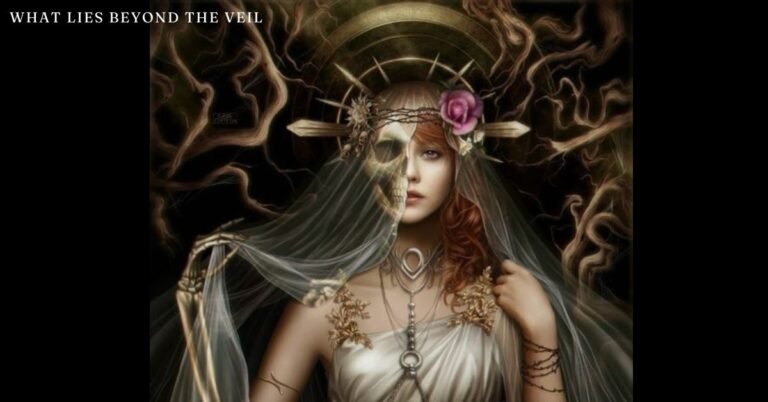Introduction: Peering Into the Beyond
Throughout history, humans have pondered the great unknown—what lies beyond the veil of reality, perception, and existence itself. Whether interpreted as a metaphor for the supernatural, a philosophical concept, or a scientific enigma, this phrase evokes curiosity and intrigue. Some believe it signifies the afterlife, while others associate it with parallel dimensions, hidden knowledge, or the mysteries of the subconscious mind.
Understanding what lies beyond the veil requires an exploration of various perspectives, including spirituality, science, mythology, and psychology. This article will delve into these aspects, offering insights into what may exist beyond our immediate perception. By examining ancient beliefs, modern theories, and personal experiences, we aim to shed light on the mysteries that have captivated humanity for centuries.
The Veil as a Metaphor: Exploring Its Meaning Across Cultures
The phrase “what lies beyond the veil” has been used in multiple ways across different cultures and traditions. In many ancient civilizations, the veil symbolized the boundary between the physical world and the spiritual realm. For example, in Egyptian mythology, the veil separated the land of the living from the afterlife, where souls underwent judgment before reaching the afterworld. Similarly, in Greek mythology, the River Styx was believed to serve as a veil between the mortal world and the underworld.
In religious contexts, people often view the veil as a barrier separating humanity from divine truth. Christianity, for instance, describes how the veil in the Temple of Jerusalem tore at the moment of Christ’s crucifixion, symbolizing humanity’s newfound access to spiritual knowledge. In Hinduism, Maya, or illusion, blinds individuals from perceiving the ultimate reality—Brahman, the eternal truth.
From a psychological standpoint, the veil represents the limits of human consciousness. Sigmund Freud and Carl Jung discussed the existence of the subconscious mind, suggesting that deeper truths about human nature and the universe lie hidden beneath the surface of conscious thought. Thus, in a metaphorical sense, uncovering what lies beyond the veil can mean seeking enlightenment, self-awareness, or higher knowledge.
Scientific Perspectives: Is There More Than Meets the Eye?
Science, while rooted in empirical evidence, also explores concepts that challenge our understanding of reality. Quantum physics, for instance, suggests that the universe operates on principles beyond human perception. The double-slit experiment demonstrates how particles can behave as both waves and particles, implying the presence of unseen dimensions influencing reality.
String theory proposes the existence of multiple dimensions beyond the three-dimensional world we experience daily. If true, this means that what lies beyond the veil could be an entirely different realm of existence, where alternate realities coexist alongside our own. The concept of dark matter and dark energy further supports the idea that much of the universe remains hidden from human sight, composing approximately 95% of the cosmos.
Additionally, neuroscience provides insights into how the brain interprets reality. Studies on altered states of consciousness show that meditation, near-death experiences (NDEs), and psychedelics limit human perception and reveal hidden aspects of existence through different states of awareness. Could these altered states allow us to peek beyond the veil, even momentarily? Many researchers believe this is possible, though conclusive proof remains elusive.
Spiritual and Mystical Interpretations: Beyond the Physical World
Spiritual traditions worldwide have long suggested that beyond the veil lies a realm of spirits, deities, and higher consciousness. Many religious and esoteric beliefs propose that death is merely a transition rather than an end. In Christianity, Islam, and Judaism, the soul is thought to persist beyond death, entering heaven, hell, or another plane of existence.
Eastern philosophies such as Buddhism and Hinduism embrace the concept of reincarnation, suggesting that the soul continuously crosses the veil between life and death. Tibetan Buddhist teachings speak of the “Bardo” state, an intermediate realm where souls undergo transitions before rebirth.
People who claim to have traveled beyond the veil describe mystical experiences such as astral projection and out-of-body experiences (OBEs). Shamans, mystics, and psychics often report visions of otherworldly entities or alternate dimensions during deep spiritual states. While skeptics argue these experiences are the result of brain activity, others believe they offer glimpses into higher realities.
The Afterlife Debate: What Happens When We Cross the Veil?
The question of what lies beyond the veil is most commonly associated with the afterlife. Numerous theories attempt to answer whether consciousness continues after death or ceases entirely. Near-death experiences (NDEs) provide compelling, yet controversial, evidence that life may persist beyond physical death. Many individuals who have experienced NDEs describe seeing a bright light, meeting deceased loved ones, or feeling an overwhelming sense of peace.
Scientific studies suggest that brain activity may create NDEs rather than allowing an actual journey to another realm. However, cases where individuals accurately recall details that should have been impossible for them to perceive during clinical death challenge purely materialistic explanations.
Religious teachings reinforce the idea of an afterlife, with variations ranging from heaven and hell to reincarnation and transcendence. The concept of the soul’s journey is central to many belief systems, suggesting that what lies beyond the veil is not an abyss of nothingness, but a continuation of existence in another form.
Parallel Realities and Alternate Dimensions: A Multiversal Perspective
Could what lies beyond the veil be another version of reality? The concept of the multiverse suggests that countless parallel worlds exist alongside our own, each differing in minor or major ways. Some physicists, including proponents of the Many-Worlds Interpretation, argue that every decision creates a branching reality, meaning infinite versions of ourselves may be living out different possibilities.
If true, this would mean the veil may separate not only life and death but also different versions of existence. Some people who have experienced déjà vu or the Mandela Effect speculate that they have briefly crossed into alternate realities, glimpsing what lies beyond the boundaries of our dimension.
Moreover, folklore and paranormal accounts often describe encounters with beings that appear to exist outside of our normal reality—shadow figures, ghosts, or interdimensional entities. Whether these experiences are psychological projections or evidence of alternate dimensions remains a subject of debate.
How to Lift the Veil: Seeking Truth Beyond Perception
For those who wish to explore what lies beyond the veil, various practices aim to expand perception and access hidden knowledge. Meditation, for example, is a powerful tool used across spiritual traditions to quiet the mind and access deeper states of awareness. Some individuals report profound insights or mystical experiences through deep meditation.
Lucid dreaming, the practice of becoming aware within dreams, allows individuals to navigate dream worlds consciously, potentially offering glimpses into other realms. Similarly, astral projection techniques are believed to enable travel beyond the physical body, reaching spiritual planes.
Scientific inquiry also plays a role in lifting the veil. Advancements in artificial intelligence, virtual reality, and neuroscience may one day provide answers to questions about consciousness and perception. As technology progresses, our understanding of what lies beyond the veil may evolve, revealing truths that were once thought to be purely speculative.
Conclusion: Embracing the Unknown
The phrase “what lies beyond the veil” carries profound significance across various disciplines, from spirituality to science. Whether interpreted as the afterlife, hidden dimensions, or deeper consciousness, the quest for understanding remains one of humanity’s greatest pursuits.
While absolute answers may still be beyond our grasp, exploring these mysteries allows us to expand our perception of reality. The journey itself—the search for knowledge, self-discovery, and deeper awareness—may ultimately be what lies beyond the veil.

